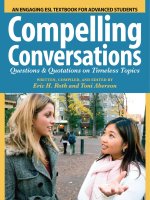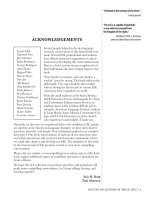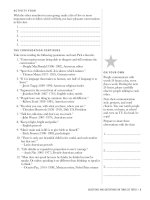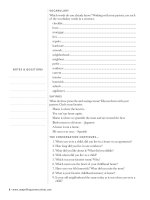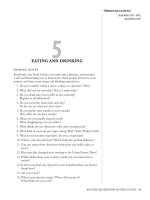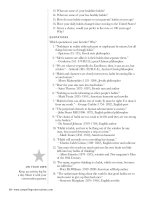Compelling Conversations 2
Bạn đang xem bản rút gọn của tài liệu. Xem và tải ngay bản đầy đủ của tài liệu tại đây (151.67 KB, 5 trang )
Questions And QuotAtions on timeless topics • v
“Gratitude is the memory of the heart.”
French proverb
“No one is as capable of gratitude
as one who has emerged from
the kingdom of the night.”
Elie Wiesel (1928–), American
writer and Nobel Peace Prize winner
ACKNOWLEDGEMENTS
Several people helped in the development,
research, and creation of this hybrid ESL text-
book. Several ESL professionals and students
have offered numerous suggestions at critical
moments in developing this conversation book.
Here is a brief, and no means complete, list of
kind individuals who have helped improve this
book.
“Everybody is a student, and everybody is a
teacher” goes the saying. This book reects that
philosophy. The eager students that worked
with us during the last decade in various ESL
classrooms have expanded our world.
From the adult students at the Santa Monica
Adult Education Center, Indianapolis Ivy Tech,
and Community Enhancement Services at-
tending classes while working difcult jobs to
energetic American Language Institute students
in Long Beach, Santa Monica Community Col-
lege, and UCLA Extension, you have shared
your experiences and insights. Thank you.
Naturally, we also owe an exceptional debt to the ambitious USC gradu-
ate students at the American Language Institute; we have often shared
questions, proverbs, and laughs. Your enthusiasm pushed us to complete
this project. Our lively conversations, in and out of the classroom, have
exceeded expectations and created small classroom communities where
we could take chances and develop our skills. The adoption of this book
by the Conversation Club promises to lead to even more compelling
conversations.
Please visit our website, www.compellingconversations.com, to offer feed-
back, suggest additional topics, or contribute questions or quotations for
future editions.
We hope this rich collection of questions, proverbs, and quotations will
spark many compelling conversations. Let’s keep talking, sharing, and
learning together!
Eric H. Roth
Toni Aberson
Laurie Selik
Zigmund Vays
Jim Valentine
Idalia Rodriguez
George Rodriguez
Adam Rado
Regina Pablo
Sharon Myers
Nina Ito
Alla Kogan
Oleg Khalkevich
Paula Johnson
Ben Hammer
Marina Goldshteyn
Ronit Frazam
Rosa Dreizin
Mark Chumley
Elaine Afable
Lucienne Aarsen
Questions And QuotAtions on timeless topics • vii
INTRODUCTION
“Colors fade, temples crumble,
empires fall, but wise words endure.”
Edward Thorndike (1874–1949),
American psychologist
The art of conversation, once considered the sign of a civilized individual,
seems less common today. Yet I treasure the moments of sharing experi-
ences, collecting news, and exchanging ideas. I make a point of knowing
my neighbors, allowing casual greetings to become long conversations,
and making time to explore in depth the feelings and perceptions of
friends and relatives. These natural conversations provide information,
encouragement, laughs, and pleasure.
Many people say that they are too busy to have long talks. Other people
prefer to watch television, play computer games, or listen to the radio
rather than talk to relatives and friends. Sometimes people feel too shy to
speak to the people next to them. Many Americans have forgotten how
to hold good, deep conversations, or even a friendly chat on the phone. I
suspect this lack of real communication lessens their daily joy.
Of course, people learning English as a second, third, or fourth language
face even more barriers to a satisfying conversation in English. First,
English remains a confusing, difcult, and strange language. It’s easy to
feel uncomfortable when speaking in this new tongue. What questions do
I ask? How can I keep a conversation going? What vocabulary words are
needed? How do I show agreement, or disagreement, in a lively, yet polite
way? How can I share my experiences in a clear manner? How can I have
better, more engaging conversations in English?
Compelling Conversations: Questions and Quotations on Timeless Topics addresses
these issues for both native and non-native speakers. The focus is on learn-
ing by doing, and making good mistakes. (Good mistakes, by the way, are
natural mistakes that help us learn so we can make different and better
“good mistakes” next time.)
Each of the 45 chapters includes 30 or more questions, 10 or more
targeted vocabulary words, a few proverbs, and 10 or more quotations.
Although designed for advanced students, intermediate ESL students will
nd plenty of material to use and can benet from exposure to the new
words, phrases, and questions.
Each chapter focuses on a promising conversation topic. The questions
allow the reader to practice exchanging experiences and ideas in a natural
style. You can add questions, skip questions, and move on to related topics.
Each chapter begins with easier questions and moves on to questions that
are more abstract. Both native and non-native speakers will nd the ques-
tions allow one to share experiences, exchange insights, and reect on life.
A note on terms
ESL, short for English as a
Second Language, remains
the most common term in the
United States—especially in
public education.
TESOL, the largest
professional organization,
stands for Teachers of
English to Speakers of Other
Languages. Many scholars
prefer to break down the eld
into sub-categories such as:
EFL: English as a Foreign
Language
ESP: English for Special
Purposes
ELT: English Language
Teaching, and
ELL: English Language
Learners.
We use ESL for both simplicity
and convenience since we live
in the United States.
viii •
www.compellingconversations.com
A few more tips for
satisfying conversations
with your partners:
• Be active
• Be curious
• Be encouraging
• Be kind
• Be open
• Be tolerant
• Make good mistakes
• Be yourself
The questions are conversation starters, and not scripts to follow. The goal
remains to create a real dialogue, increase your understanding of your
classmates, and gently push you toward using a richer vocabulary in your
English conversations.
Many of these conversation worksheets were originally developed for
an Advanced Conversation class that met four hours a week, 15 weeks
a semester. The original college course textbook offered little more than
vocabulary lists, cost too much, and avoided any topic that might cause
any controversy. Several lessons talked about the weather, colors, etc. So
I dropped the book, and created conversation worksheets with 30 related
questions on practical topics for adult students. I didn’t come in with a
set point of view; I wanted to nd out what people had experienced and
their reections on their lives, current events, and the bigger questions
about our changing world. Why should we just talk about the weather
and become bored when we could explore our lives, times, passions, and
challenges?
Many students would contribute proverbs during our discussions since
proverbs, sayings, and idioms can be useful in daily life. Often similar
ideas, like “the sky is always blue somewhere”, can be found across
cultures. Proverbs can point out some universal aspects of the human
experience— in 21st century America, 19th century England, 17th
century Paris, 4th century China, or 1st century Rome. Proverbs may
often contradict each other, yet the trick is to use the right proverb at the
right time in the right situation. Sometimes it’s good to know, and even
hold, two opposite ideas. “Where you stand, depends on where you sit.”
Therefore, each chapter includes a proverb section.
This collection of proverbs and quotations also includes many insights
from religious leaders and philosophers that go back even more than
2,000 years such as Buddha, Confucius, Aristotle, and the Biblical
prophets. These quotations remind us that some conversations have
spanned centuries and cultures. The selected quotations present a wide
range of ideas, beliefs, and perspectives. Some quotations might make you
laugh, some might make you sigh, and a few might even annoy you. Share
your genuine feelings and reasons. Join the conversation. Free speech
remains a rare and precious right.
Including classic quotations also helps preserve the insights and comments
of well-known and signicant cultural gures. This habit helps us escape
the too-common delusion that the world began when we were born and
provides a larger perspective. Sometimes knowing the speaker and histori-
cal era invites another way of looking at our modern lives.
Your English may not be perfect yet, but daily practice does lead to
signicant progress. Compelling Conversations gives you the tools and
phrases to talk more and listen better to friends and strangers in English.
Finally, I hope you enjoy creating many compelling conversations!
Eric H. Roth
Contents
SECTION 1 YOUR LIFE
1. Getting Started ................................................. 1
2. Going Beyond Hello ......................................... 4
3. Being Home ..................................................... 7
4. Describing Family Ties .................................. 10
5. Eating and Drinking ...................................... 13
6. Exploring Daily Habits .................................. 16
7. Being Yourself ............................................... 19
8. Staying Healthy ............................................. 22
9. Parenting ........................................................ 26
10. Making and Keeping Friends ...................... 29
11. Loving Dogs and Pets .................................. 32
12. Cats and More Cats .................................... 35
13. Pet Peeves ..................................................... 38
SECTION 2 FREE TIME
14. Traveling ...................................................... 42
15. California Calling ........................................ 45
16. Reading Pleasures and Tastes ..................... 48
17. Moving to Music ......................................... 51
18. Talking about Television ............................. 54
19. Talking about Movies .................................. 57
20. Talking about Movies: The Sequel ............. 60
21. Playing and Watching Sports ...................... 63
22. Gardening .................................................... 67
23. Enjoying the Beach ...................................... 70
24. Holidays and Celebrations .......................... 73
SECTION 3 MODERN TIMES
25. What Do You Think? .................................. 78
26. Change ......................................................... 82
27. Clothes and Fashion .................................... 85
28. Appreciating Physical Beauty ...................... 89
29. Dating .......................................................... 93
30. Enjoying Money .......................................... 96
31. Eating Out ................................................... 99
32. Gambling and Spending Money ............... 102
33. Do You Match? ......................................... 105
34. Handling Stress .......................................... 109
SECTION 4 CIVIC LIFE
35. Practicing Job Interviews ........................... 114
36. Work Relationships .................................... 117
37. Learning in School .................................... 120
38. Studying English ........................................ 124
39. Coming to America .................................... 127
40. Exploring American Culture ..................... 130
41. Exploring Cities ......................................... 133
42. Driving Cars .............................................. 136
43. Crime and Punishment ............................. 139
44. Voting and Choosing Leaders ................... 142
45. Searching for Heroes ................................. 145
APPENDIX
Tips & Gentle Advice for
ESL/EFL
Teachers ... 150
Bibliography .................................................... 151
